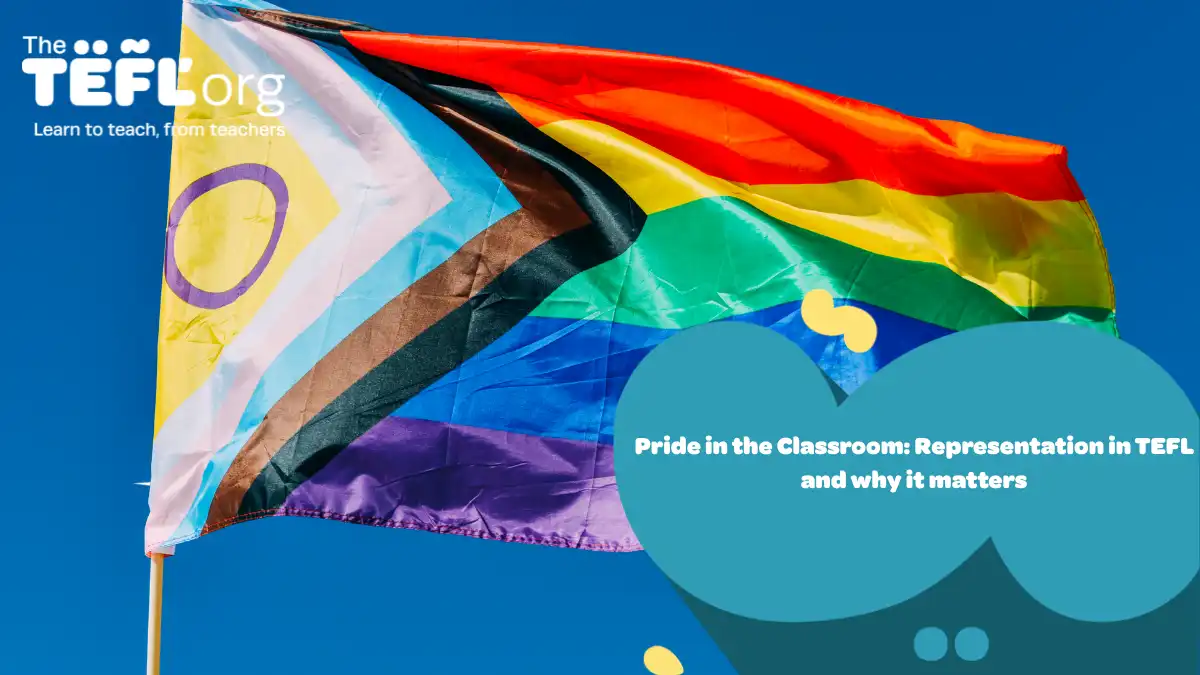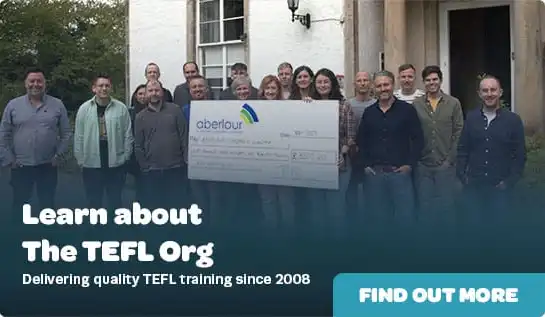- TEFL Courses TEFL Courses
- View all TEFL courses
- 120-hour Premier Online TEFL Course
- 250-hour Level-5 Online TEFL Course
- Online TEFL Courses
- Classroom TEFL Courses
- Combined TEFL Courses
- Virtual TEFL Courses
- TEFL Course Bundles NEW
- Advanced TEFL Courses
- TEFL Lesson Plans & Resources
- TEFL Gift Vouchers
- Which TEFL course is right for you?

- New to TEFL New to TEFL
- Locations
- TEFL Jobs
- Teach Abroad Teach Abroad
- Teach English Abroad
- Teach English in Japan
- Teach English in South Korea
- Teach English in Spain
- Teach English in China
- TEFL Salaries Abroad
- Requirements for teaching abroad
- Teach English abroad without a degree
- How to find teaching jobs abroad without experience
- Can you teach English abroad as a non-native speaker?

- Teach Online
- About Us
- Blog
- Podcast

Pride in the Classroom: Representation in TEFL and why it matters
Teaching English as a foreign language is more than just a job. It’s a chance to make a meaningful difference in people’s lives. One of the best and most important ways TEFL teachers do this is by creating inclusive, respectful spaces where all students feel welcome. For LGBTQ+ teachers, simply being visible in the classroom can be a form of representation that challenges stereotypes and builds understanding.
TEFL is one of the most globally accessible and diverse professions. Teachers come from all manner of backgrounds and work with learners of different ages, abilities, and cultures. This diversity can be one of the most rewarding aspects of the job, but it also calls for awareness, sensitivity, and openness to perspectives that may differ from your own.
Many LGBTQ+ teachers find TEFL is a welcoming career. However, levels of acceptance can vary widely depending on where you teach. In some countries or regions, it may be necessary to approach topics related to identity and representation with care, particularly when navigating local laws or cultural expectations.
For Pride Month, we’re looking at why LGBTQ+ representation matters in the TEFL classroom, what challenges teachers may face, and how to build inclusive environments where all learners, and teachers, can thrive.

TEFL: a diverse option?
One of the best things about TEFL is how diverse it can be, from the people who do it, to the places they go and the lives they change.
Anyone with fluency in English can take a TEFL course , and millions do. Actually, scratch that - anyone with fluent English and curiosity about other people, cultures, and the wider world can take a TEFL course.“You work with and teach so many age groups and people from different backgrounds, it’s a real mixed bag”, says The TEFL Org’s Operations Manager and former teacher, Alan Moir. Alan taught in Spain.
“I’d say it’s one of the most open and inclusive professions. Obviously, much depends on being culturally aware and sensitive. Not everyone has the same viewpoints, and not everyone necessarily agrees (on a number of matters), but everyone I came across was respectful.”
The TEFL Org’s Head of Education, Thomas Kerr , agrees. Like Alan, Thomas has experience teaching in Spain, but has also worked in France and Portugal.
“I’ve found TEFL to be a welcoming environment for LGBTQ+ teachers, particularly in international schools and language centres that value diversity.
“That said, the level of acceptance can vary greatly depending on the country and the institution’s culture. In more conservative regions, it’s sometimes necessary to navigate LGBTQ+ topics with care or discretion, especially when local attitudes or laws are less supportive. Still, I’ve seen how inclusive teaching practices, like using diverse examples or encouraging respectful discussion, can make a big impact.”
TEFL is a genuinely global profession, one that brings people from all walks of life to share experience. As Alan and Thomas highlight, it’s not only accessible to anyone with fluent English and a sense of curiosity. It’s built on respect, cultural exchange and curiosity about the world.

Why representation matters
So, why does LGBTQ+ representation matter? Why is it important for LGBTQ+ teachers to be represented in a classroom environment? Aren’t classrooms just about teaching?
Imagine if everyone you saw in school or university looked and thought the same. Your understanding of the world would be limited. A diverse classroom reflects the wider society and helps students gain a broader, more inclusive perspective.
“When I first started teaching in TEFL spaces, LGBTQ+ representation was often minimal or completely absent”, Thomas explains.
“Coursebooks did not include same-sex couples, non-traditional families, or diverse gender identities, and when they did, it was usually as a token example rather than integrated naturally into the content.”
Thomas notes that, in educational materials, the “default” experience of learning about families covered heterosexuality, and nothing else.
“In many classrooms, there was an unspoken assumption of heteronormativity, with roleplays and discussions defaulting to “husband and wife” or “boyfriend and girlfriend.” That said, over time, I saw more teachers, especially younger ones, begin to incorporate inclusive examples and challenge that default.”
This doesn’t just benefit LGBTQ+ teachers. It can benefit students who are LGBTQ+, or have families which don’t fit the straight, nuclear stereotype. Moving away from assumptions about relationships and family structures helps create a more welcoming environment for everyone.

The importance of Pride
One particular experience really stuck out for Thomas:
“One of the most memorable moments was during a class project on cultural celebrations. I included Pride Month as one of the options, and a group of students chose to research and present on how Pride is celebrated around the world. They were fascinated by the history, the symbolism of the rainbow flag, and the idea that Pride could be both a celebration and a protest.”
That fascination in Pride and the wider context show how important teaching moments can be. When students are encouraged to explore and engage with LGBTQ+ topics, it broadens cultural awareness, but also creates more respectful classroom environments.

Navigating the world as an LGBTQ+ TEFL teacher
While TEFL offers the chance to travel widely and experience new cultures, not every destination is equally safe or welcoming for LGBTQ+ teachers. In many parts of the world, living openly as an LGBTQ+ person remains extremely difficult. Same-sex marriage is still outlawed in dozens of countries, and trans rights face increasing legal and social challenges—even in places like the UK , where progress once seemed more secure.
These realities can limit the choices available to LGBTQ+ teachers. Countries in the Middle East, for instance, are often home to some of the most competitive salaries and attractive teaching packages. But for many, the legal and social climate makes working there dangerous, and a difficult option to weigh up.
Alan, The TEFL Org’s Operations Manager, reflected on this dilemma after completing a contract in Spain.“I did look into teaching English in the Middle East after completing my contract in Spain. That was short-lived; I ultimately decided against it. There are obviously financial and professional development incentives to teaching in the Gulf States, but I think the need to constantly mask and have my guard up would take a massive toll on my mental health, and it’s just not worth it.
“I’d be sacrificing a lot of the progress I’ve made and compartmentalising parts of my life which I’m proud of.”
Tools like the LGBTQ+ Travel Safety Index and Global Trans Rights Index can help inform decisions, highlighting where protections exist - and where risks are higher. The fact that such tools are necessary says a lot. Visibility in the TEFL world isn’t just about celebration. It’s about safety and making informed choices. For LGBTQ+ teachers, representation is more than symbolism or gesture, it’s a practical and emotional lifeline.
What can teachers do?
We all have a role to play in supporting the LGBTQ+ community. Both in our personal lives and in the workplace, everyone has a role to play. While LGBTQ+ individuals are sometimes expected to lead conversations around inclusion, that responsibility shouldn’t fall solely to them. It’s just as important for allies to step up, listen, learn, and advocate. Being an ally means actively supporting and standing with marginalised communities, including LGBTQ+ people, and helping to create safer spaces for everyone.
By embedding inclusivity in all of our teaching, as well as during Pride month - whether that’s creating lessons on LGBTQ+ history or encouraging conversation about inclusivity - we can help tackle stigma and prejudice.
Thomas told us about a learning experience that left a real mark on him:
“While teaching teenagers at an English at a language academy in Madrid, I included a lesson on family and relationships.
“After class, one of my students quietly came up to me to thank me for that lesson. They said they had never heard a teacher talk about families like “theirs.”
“They later told me they had two mums. They often felt like they had to hide that part of their life at school. Just by being open and respectful in how I taught, I unknowingly created a safe space for them to feel seen. It reminded me how powerful visibility and thoughtful representation can be, not just in what we say, but in the atmosphere we create.”
Allyship and supporting marginalised people can have surprising and fantastic results. By creating classrooms that reflect and respect all identities, teachers can challenge stigma, and make space for every student and their background.
Materials matter
Alan agrees that diversifying learning materials is essential. He also shows that teachers can make small gestures to help create the welcoming environment every classroom should have.“Lessons can be more representative through the learning materials. Using inclusive language, pronouns, imagery and talking about different kinds of relationships and family dynamics is crucial. Recognising Pride Month and LGBT History Month is a great way to open discussions.
It depends on your school, but rainbow lanyards aid inclusion. Same with posters on the walls, and if you’re doing online classes, display your pronouns alongside your name.”
While the topic of Pride and LGBTQ+ issues in the classroom can seem large and profound, it really can be as simple as lanyards and displaying pronouns. These are easy things that can make a world of difference.

Celebrate Pride in the classroom
Inclusion isn’t a one-off lesson or a monthly theme. It’s something powerful that lives in the everyday choices teachers make. From the examples we use in teaching materials to the classroom conversations we encourage, inclusive teaching helps students feel seen, valued, and respected for who they are. Representation matters.
Visibility and empathy can be life-changing for LGBTQ+ teachers and students. For allies, there’s huge power in listening, learning, and standing up for others. Pride reminds us of the importance of that visibility. However, the real impact happens year-round when teachers create spaces that reflect the diversity of the world outside.
Whether you're just starting your TEFL journey or are already in the classroom, you have a chance to make a difference. Inclusivity is built by everyone, and every action, whether it’s small or big, has the power to effect change.
Join the global community of teachers working abroad or online. The first step is taking a high-quality course with The TEFL Org.










